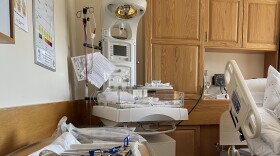What do you really know about placentas? If you’re like the majority of people, the "tree of life" is probably pretty mysterious. Despite being vital to both maternal and fetal health, the National Institute of Child Health and Development says that the placenta is the “least understood human organ.” That’s starting to change as more scientists study the invasive organ, a pattern Denise Grady wrote about for the New York Times, but outside the laboratories people are taking the placenta into their own hands. Literally. So we asked: what are some of the most popular and strange things people are doing with their placenta?

Art: The tree-like look of placenta has been noted for centuries, by cultures all over the world. If you’d like to capture that image in a piece of art, there are artisans who specialize in making casts or placenta jewelry. Prints in particular have taken off and producer Taylor Quimby offered us a step-by-step placenta print tutorial if you’d prefer to do it yourself.
Taylor's Tips For Placenta Prints
1. Get a box to put everything on standby, at least a few weeks before the due date. This isn't something you'll want to figure out day of.
2. Hit up your scrapbooking friends for supplies like rollers and sponges. Get some ink or paint. Helpful tip, darker colors work best. You can paint the background on some canvases beforehand to have some options.
3. Rinse the placenta off, pat it dry. Stop and appreciate that you're holding a human organ in your hands.
4. Roll ink on on the tree-like side and press the paper to the placenta. To get a clearer print, especially around the stem, you'll probably want to flip the whole thing over and let gravity help out.
5. Get artsy! If you don't like the first print, go for a second or third try. You should have that grab-bag of art supplies on hand - in case inspiration strikes you, you want to be prepared.

Plant It: If those other suggestions don’t appeal to you, this idea might. People are planting their afterbirth in gardens, or underneath trees. The idea is that the placenta can then return any nutrients to the Earth, and enrich bonds to nature in a circle-of-life manner. This tradition is actually found in other cultures, like Maori and Navajo, where it has been practiced for centuries. The US people are using it to nourish trees which can serve as a more permanent symbol in family yards and gardens.
Teddy Bears: Looking at pictures of these stuffies, you can hardly tell they might have stranger than normal origins. Though maybe that’s being optimistic. Basically, the placenta gets treated in a curing process and is then used for the skin of a one of a kind teddy bear. Designer Alex Green started making the bears in 2008 and describes them as feeling like something in between leather and suede, though flexible. Huggable. Not the first adjective to come to mind when thinking about placentas, but now, thanks to Green, not the last.

Eat It: Now follow this for a minute. Does “eating it,” meaning “eating the placenta that has just followed your child out of the womb” have a high initial gross factor? Yes. Does that wear off after learning more about the practice? Not entirely. But it is very interesting, and just might be a topic that comes up at the next baby shower/ medical conference/ conversation with someone who is pregnant.
Although no clinical studies have proven that the placenta can pass any of the vital nutrients it collects onto the mother if eaten, the trend is on the rise in the US. Placentas can be eaten raw, frozen and put into smoothies, and even steamed then dried then crushed into a powder which is put into capsules – one of the most popular methods. People who eat the afterbirth usually prescribe to the idea that eating the organ can help with post-partum recovery and lactation, among other things. And though it hasn’t been scientifically proven to help, it hasn’t hurt either – most mothers who consumed the placenta after the birth of one child said they would do it again the next time around.
You can hear the full interview with Denise Grady, New York Times reporter who wrote the article “The Mysterious Tree of a Newborn’s Life: The Push to Understand the Placenta,” here.
And we want to know: what did you do with the placenta after your child was born? Would you consider one of these options in the future? Let us know in the comments below, or on Facebook or Twitter.







